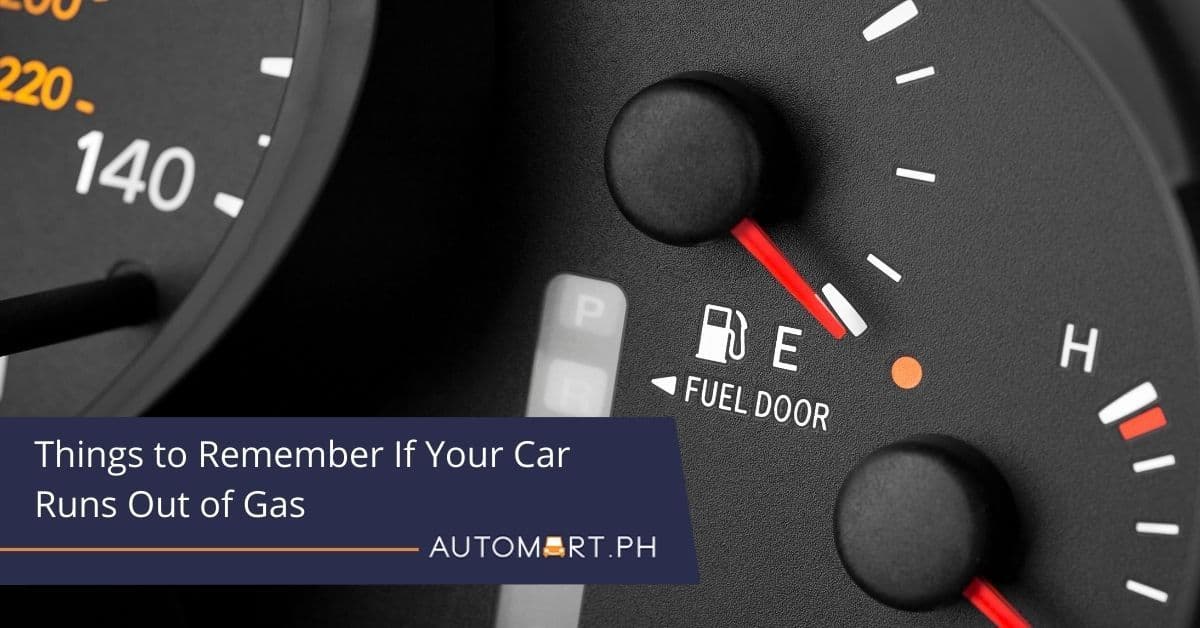
Things to Remember If Your Car Runs Out of Gas
Updated on December 18 2025
The engine in your car needs three essential things to produce power: air, fuel, and spark. If it lacks any of the three, the engine will refuse to start or cease to operate. If the motor is short in spark or air, it will still run, although the engine will sputter or vibrate incessantly. But if it runs out of gas, it will shut down the moment the fuel tank goes dry, leaving you stranded in the middle of nowhere.
What happens if my car runs out of gas?
So yes, the engine will shut off if the fuel supply runs out. Before this happens, you may notice a few noticeable symptoms before the needle goes empty, including backfiring, sputtering, or power surges. You will also see a loss of power and responsiveness from the throttle pedal as the engine is starving for gas.

When the engine shuts down, you also lose hydraulic and electrical power to operate the brakes and power steering. The result is a car that could be hard to control if you run out of gas while traveling at speed.
Will my engine get damaged if the car runs out of gas?
The good news is you won’t be damaging your precious engine if the car runs out of fuel. However, some problems may occur to the fuel system, particularly the fuel pump. The fuel pump is inside the fuel tank in a modern car, where it needs gas to cool and lubricate itself. If the tank is running dry, the fuel pump could overheat and cause it to fail. And when it does, the pump could self-destruct and spew out debris that could get lodged into your car’s fuel system.

As you can tell, a broken fuel pump is bad news, but there’s more. Even if the fuel pump does not fail, persistently driving with deficient fuel could wreak havoc on the fuel filter. The filter is also inside the fuel tank, where it could suck up harmful sediments and debris from the bottom of the tank. If this happens, the contaminants could clog the fuel injectors, leading to an expensive and meticulous repair job.
That’s not all. Even if the fuel pump survives the ordeal and there are no sediments on the tank to ruin the injectors, there is a danger of sucking air to the fuel lines if the pump operates on empty. It may take a while to restart your car when this happens, particularly if you have a diesel engine.
What To Do If Your Car Runs Out of Gas
Here are tips to consider if you feel your car is running out of gas.
1. Confirm your suspicions.
Check the fuel gauge to confirm the tank is running on empty. If you see an illuminated low fuel warning light in the instrument cluster, your first instinct should be to find the nearest gas station and fill it up with gas. But if you happen to be far away from the nearest fuel pump, proceed to the next tip.
2. Slow down and stay near the side of the road.
If your vehicle is seriously low on gas, slow down and stay near the side of the road to anticipate a dying engine. If symptoms of sputtering or surging are apparent, pull over immediately before the engine dies completely. After stopping the car, turn off the engine, engage the handbrake, and turn on the hazard lights. Do NOT attempt to restart the engine.

3. Call for help.
After running out of gas and stopping the car, the next best thing is to call for help. If you happen to be on the highway, the safest bet is to wait for roadside assistance while inside the car. But if it’s safe to do so and there’s a gasoline station nearby, you can walk there and return with gas.
How do I restart my car after running out of gas?
If you bought some gas, pour everything into the fuel tank and screw back the fuel cap. If your vehicle has a conventional ignition with a key, turn the key over to the second notch to prime the fuel pump. Repeat this three to five times. Better still, try stepping on the gas pedal after turning the key to remove air from the fuel system. This method will re-pressurize the fuel system so the engine can start without a hitch. After priming the system, you can proceed in turning the key to start the engine.

If your car has a push-button start, press the button twice without pressing your foot on the brake pedal to prime the fuel pump. Repeat this step two or three times before stepping on the brake pedal and pushing the start button.
But if you have a diesel, you will need to bleed the system manually after filling the tank, which could probably require a visit to your mechanic. However, you can prime the fuel pump on newer diesel cars or trucks by turning the key to the ON position for 30 seconds without starting the engine. Next, turn the ignition OFF, wait five seconds, and try restarting the engine.
Conclusion
The general rule is to fill up with gas or diesel when the fuel level falls to a quarter of the tank or a notch above empty. Do not wait for the needle to point to empty before filling up with gas to prevent issues with the fuel system.